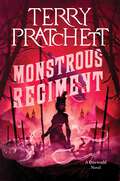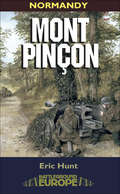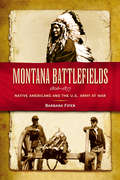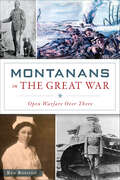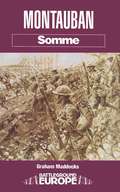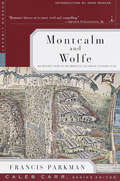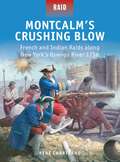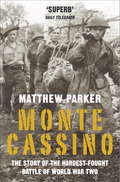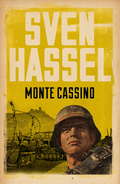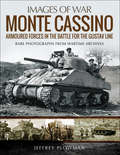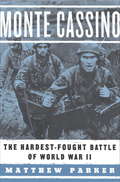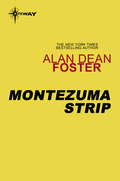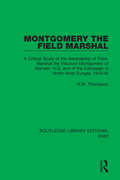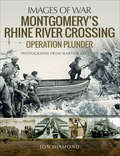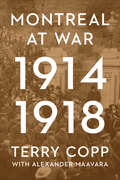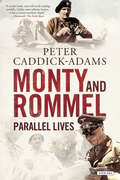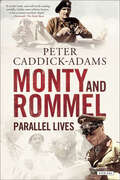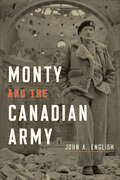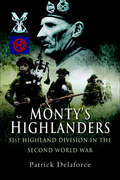- Table View
- List View
Monstrous Regiment: A Novel Of Discworld (Discworld #31)
by Terry Pratchett“Wickedly satirical . . . nothing short of brilliant.”—Publishers Weekly (starred review)New York Times bestselling author Sir Terry Pratchett explores the inanity of war, sexual politics, and why the best man for the job is often a woman in this acerbically funny and poignant Discworld novel.In the small country of Borogravia, there are strict rules citizens must follow. Women belong in the kitchen—not in offices, pubs, nor pants. And certainly not on the front lines when war comes to Discworld.Polly Perks took over running her family’s humble inn when her brother, Paul, marched off to war. But it’s been more than two months since his last letter home, and the news from the front is bad. To find her missing brother, the resourceful Polly cuts off her hair and joins the army as a young man named Oliver.As Polly closely guards her secret, she notices that her fellow recruits seem to be guarding secrets of their own. And before they’ve learned to properly march, Polly and her fellow raw recruits find themselves in the thick of a losing battle. All they have on their side is the most artful sergeant in the army and a vampire with a lust for coffee.No matter, it’s time to make a stand. . . .The Discworld novels can be read in any order but Monstrous Regiment is a standalone.
Mont Pinçon: Normandy (Battleground Europe)
by Eric HuntIn late July 1944 the Allies began their breakout from the Normandy beachheads. The Americans in Operation COBRA and the British in Operation BLUECOAT. VIII and XXX British Corps were to seize the dominating ground running north west from Mont Pincon and exploit towards Vire. Mont Pincon is the highest hill in Normandy and is a formidable obstacle as well as magnificent observation post. The Germans saw it as essential to their defensive plans for Normandy. Three armored and three infantry divisions, together with two armored brigades, were hurriedly regrouped for the BLUECOAT advance into the bocage, in which determined German resistance meant that it was 5 August before the 'mountain' itself could be tackled. The Guide outlines the principal actions of BLUECOAT, but concentrates on the key players in the assault on Mont Pincon: 43rd Wessex Division and 8th Armoured Brigade. Contemporary accounts, including personal diaries, as well as more recent personal interviews are also covered.
Montana Battlefields, 1806-1877: Native Americans and the U. S. Army at War
by Barbara FiferMontana's era of "Indian Wars" consisted of nearly a century of skirmishes, battles, and large-scale wars between the U.S. military and native nations, including Blackfeet, Sioux, Northern Cheyennes, Arapahos, Gros Ventres, and Nez Perces -- and the army's Crow and Shoshone allies. These battlegrounds remain today, a testament to the clash of cultures that defined the region in the nineteenth century.Author Barbara Fifer takes readers on a historic journey to the solemn sites of Montana's most fascinating and storied battles, from Two Medicine Creek to the Little Bighorn and on to the Sweetgrass Hills, revealing engaging tales -- from fighters and witnesses on both sides.
Montanans in the Great War: Open Warfare Over There (Military)
by Ken RobisonWorld War I continued with fury in the spring of 1918 as American Yanks endeavored to play the key role in stemming the German tide. Montana's Marines suffered the bloodiest day in their history as they became "Devil Dogs," charging through hell on earth at Belleau Wood. Locals in the Wild West Division stormed "over the top" into the Argonne Forest, while nurses, "hello girls," Navy Yeomanettes and YMCA workers blazed new gender roles. And young Seaman Mike Mansfield, future legendary senator, served on convoy duty against lurking German U-boats. Award-winning historian Ken Robison illuminates the story of young and vibrant Montanans of all ethnicities as they fought for elusive democracy, at home and abroad, in this world war to end all wars.
Montauban: Somme (Battleground Europe)
by Graham MaddocksMontauban was the southernmost of the Somme villages attacked by the British Army on 1 July, 1916, and it was where there was the greatest success. This new book in the series takes the reader over ground where Captain Nevill kicked a football on going over the top, where the Somme cameramen took some of their most evocative footage and where Pals battalions engaged in a triumphant first major engagement.
Montcalm and Wolfe
by Francis ParkmanThis is an EXACT reproduction of a book published before 1923. This IS NOT an OCR'd book with strange characters, introduced typographical errors, and jumbled words. This book may have occasional imperfections such as missing or blurred pages, poor pictures, errant marks, etc. that were either part of the original artifact, or were introduced by the scanning process. We believe this work is culturally important, and despite the imperfections, have elected to bring it back into print as part of our continuing commitment to the preservation of printed works worldwide. We appreciate your understanding of the imperfections in the preservation process, and hope you enjoy this valuable book.
Montcalm's Crushing Blow - French and Indian Raids along New York's Oswego River 1756
by Peter Dennis Rene ChartrandWith expert analysis and lively narrative, this engaging study of the Oswego raid casts light on a daring feat of arms at the height of the French and Indian War.The year 1755 saw the rivalry between Britain and France in North America escalate along the Great Lakes into open warfare as both sides sought to overcome the other's forts and trading posts. Lord Loudoun and the Marquis de Montcalm were sent from the mother countries to take charge, but the French lost no time in seizing the initiative, adopting Canadian-style "wilderness" tactics and planning a series of raids to keep the enemy on their toes.Amid the snows of March 1756, a 360-man French, Canadian, and Indian force stormed an Anglo-American outpost named Fort Bull in a surprise attack that left few survivors and the fort reduced to charred remains. Fort Bull's fall meant that the Mohawk River, the communication route between British-held Albany and the large and important Anglo-American post at Oswego, could now be cut off. Oswego, on the shore of Lake Ontario, had a formidable garrison based in three forts, named Pepperrell, George, and Ontario. The newly arrived Montcalm was tasked with the job of taking Oswego from the Anglo-Americans.In July and August 1756, Montcalm's 3,000-strong force - including a full train of artillery, 80 pieces strong - was transported in hundreds of sailing ships and craft. The Anglo-Americans failed to spot the approaching French forces until they had landed and secured their positions. Having surrounded and invested the forts, the French soon knocked out of action a number of British guns. The British evacuated Fort Ontario and then, at 9am on August 14th, a French cannonball killed the British commander, Colonel James Mercer. His successor, Colonel John Littlehales, did not have the stuff of a hero; an hour later, the white flag went up and Oswego surrendered just in time to avert a major onslaught.The Oswego raid was an outstanding French success; it denied the British a presence on Lake Ontario for the next two years, and relieved British pressure on Fort Frontenac. It demonstrated that the use of traditional European siege tactics in an American setting could reap great rewards, and had a great influence on the French's Indian allies too.
Monte Carlo by Moonlight
by Anton Du Beke'Heart-breaking, heart-lifting, and enchanting' CAROL KIRKWOOD'Downton Abbey with dance' SANTA MONTEFIOREWelcome to 1960s Monte Carlo, a world of glitz, glamour, scandal and betrayal...Princess Grace of Monaco has invited the world-famous Forsyth Variety Company to perform at her annual high society ball. Monaco is in the heat of its preparations for the Grand Prix when the Forsyth family makes their emotional return to the city, stirring up painful memories for father Ed Forsyth.When daughter Evie Forsyth meets Formula 1 driver Charles, their chemistry is unforgettable and a passionate affair begins. Meanwhile her brother Cal Forsyth is on location with Hollywood's biggest star, his new glittering career shaken by the arrival of a stranger from his past.As the past and present collide in the sun-drenched French Riviera, will dangerous secrets destroy the Forsyth family once and for all?***Readers love Anton du Beke:'You won't be disappointed!' ⭐⭐⭐⭐⭐'Captivated me from beginning to end' ⭐⭐⭐⭐⭐'Full of gossip and glamour, wealth and privilege' ⭐⭐⭐⭐⭐'You feel as if you're watching the story unfold' ⭐⭐⭐⭐⭐'I just couldn't put it down!' ⭐⭐⭐⭐⭐
Monte Carlo by Moonlight
by Anton Du Beke'Heart-breaking, heart-lifting, and enchanting' CAROL KIRKWOOD'Downton Abbey with dance' SANTA MONTEFIOREWelcome to 1960s Monte Carlo, a world of glitz, glamour, scandal and betrayal...Princess Grace of Monaco has invited the world-famous Forsyth Variety Company to perform at her annual high society ball. Monaco is in the heat of its preparations for the Grand Prix when the Forsyth family makes their emotional return to the city, stirring up painful memories for father Ed Forsyth.When daughter Evie Forsyth meets Formula 1 driver Charles, their chemistry is unforgettable and a passionate affair begins. Meanwhile her brother Cal Forsyth is on location with Hollywood's biggest star, his new glittering career shaken by the arrival of a stranger from his past.As the past and present collide in the sun-drenched French Riviera, will dangerous secrets destroy the Forsyth family once and for all?***Readers love Anton du Beke:'You won't be disappointed!' ⭐⭐⭐⭐⭐'Captivated me from beginning to end' ⭐⭐⭐⭐⭐'Full of gossip and glamour, wealth and privilege' ⭐⭐⭐⭐⭐'You feel as if you're watching the story unfold' ⭐⭐⭐⭐⭐'I just couldn't put it down!' ⭐⭐⭐⭐⭐
Monte Carlo by Moonlight
by Anton Du Beke'Heart-breaking, heart-lifting, and enchanting' CAROL KIRKWOOD'Downton Abbey with dance' SANTA MONTEFIOREWelcome to 1960s Monte Carlo, a world of glitz, glamour, scandal and betrayal...Princess Grace of Monaco has invited the world-famous Forsyth Variety Company to perform at her annual high society ball. Monaco is in the heat of its preparations for the Grand Prix when the Forsyth family makes their emotional return to the city, stirring up painful memories for father Ed Forsyth.When daughter Evie Forsyth meets Formula 1 driver Charles, their chemistry is unforgettable and a passionate affair begins. Meanwhile her brother Cal Forsyth is on location with Hollywood's biggest star, his new glittering career shaken by the arrival of a stranger from his past.As the past and present collide in the sun-drenched French Riviera, will dangerous secrets destroy the Forsyth family once and for all?***Readers love Anton du Beke:'You won't be disappointed!' ⭐⭐⭐⭐⭐'Captivated me from beginning to end' ⭐⭐⭐⭐⭐'Full of gossip and glamour, wealth and privilege' ⭐⭐⭐⭐⭐'You feel as if you're watching the story unfold' ⭐⭐⭐⭐⭐'I just couldn't put it down!' ⭐⭐⭐⭐⭐
Monte Cassino
by Matthew ParkerThe six-month battle for Monte Cassino was Britain's bitterest and bloodiest encounter with the German army on any front in World War Two.At the beginning of 1944 Italy was the western Allies' only active front against Nazi-controlled Europe, and their only route to the capital was through the Liri valley. Towering over the entrance to the valley was the medieval monastery of Monte Cassino, a seemingly impenetrable fortress high up in the 'bleak and sinister' mountains. This was where the German commander, Kesselring, made his stand.MONTE CASSINO tells the extraordinary story of ordinary soldiers tested to the limits under conditions reminiscent of the bloodbaths of World War One. In a battle that became increasingly political, symbolic and personal as it progressed, more and more men were asked to throw themselves at the virtually impregnable German defences. It is a story of incompetence, hubris and politics redeemed at dreadful cost by the heroism of the soldiers.
Monte Cassino (Sven Hassel War Classics)
by Sven HasselSven Hassel's iconic novel about the Battle for Monte Cassino.The thunder of the guns could be heard in Rome, 170 miles away...Having survived the horrors of the Eastern Front, the 27th Penal Regiment are posted to Italy. Hitler has ordered that every position must be held to the last, and every lost position recaptured by counter-attack.Monte Cassino - a major look-out post on the German defensive line - is under attack. In the face of overwhelming Allied firepower, Sven Hassel and his comrades are ordered to hold the fortress at all costs...MONTE CASSINO is a classic Sven Hassel novel, a no-holds-barred account of frontline combat.Sven Hassel based his unflinching narrative on his experiences in the German army. He ended the Second World War in a prisoner of war camp, where he wrote his first novel LEGION OF THE DAMNED.
Monte Cassino (Sven Hassel War Classics)
by Sven HasselSven Hassel's iconic novel about the Battle for Monte Cassino.The thunder of the guns could be heard in Rome, 170 miles away...Having survived the horrors of the Eastern Front, the 27th Penal Regiment are posted to Italy. Hitler has ordered that every position must be held to the last, and every lost position recaptured by counter-attack.Monte Cassino - a major look-out post on the German defensive line - is under attack. In the face of overwhelming Allied firepower, Sven Hassel and his comrades are ordered to hold the fortress at all costs...MONTE CASSINO is a classic Sven Hassel novel, a no-holds-barred account of frontline combat.Sven Hassel based his unflinching narrative on his experiences in the German army. He ended the Second World War in a prisoner of war camp, where he wrote his first novel LEGION OF THE DAMNED.
Monte Cassino: Amoured Forces in the Battle for the Gustav Line (Images Of War Ser.)
by Jeffrey PlowmanThe battles fought between the Allied armies and the German Wehrmacht at Monte Cassino in 1944 were key episodes in the protracted Italian campaign, and the eventual Allied victory was a decisive step in the wider war to liberate Europe from German occupation. Much has been written about Cassino, but few books have chosen to tell the story through photographs to give a visual insight into the fighting and the forces involved, the conditions in which they fought, and the landscape around the Monte Cassino abbey which became a battlefield. That is why Jeffrey Plowman's photographic history is of such value.Using almost 200 wartime images, many of which have not been published before, he gives a graphic impression of the realities of the fighting as it was experienced by the troops on the ground. He focuses on the tanks the array of armored vehicles deployed by both sides which played a critical role. This aspect of Cassino has rarely been covered in such detail and in such a vivid way.The book will be of special interest to modelers and historians of armored warfare, but it will also appeal to readers who have a more general interest in the Italian campaign.
Monte Cassino: The Hardest Fought Battle of World War II
by Matthew ParkerThe six-month battle for Monte Cassino was Britain's bitterest and bloodiest encounter with the German army on any front in World War Two. At the beginning of 1944 Italy was the western Allies' only active front against Nazi-controlled Europe, and their only route to the capital was through the Liri valley. Towering over the entrance to the valley was the medieval monastery of Monte Cassino, a seemingly impenetrable fortress high up in the 'bleak and sinister' mountains. This was where the German commander, Kesselring, made his stand. MONTE CASSINO tells the extraordinary story of ordinary soldiers tested to the limits under conditions reminiscent of the bloodbaths of World War One. In a battle that became increasingly political, symbolic and personal as it progressed, more and more men were asked to throw themselves at the virtually impregnable German defences. It is a story of incompetence, hubris and politics redeemed at dreadful cost by the heroism of the soldiers.
Montezuma Strip
by Alan Dean FosterThe ultimate maquiladora. Montezuma Strip: First World tech and Third World wages, sprawling from L.A. to East Elpaso Juarez, Guyamas to Phoenix; a thousand gangs, a million locos; and a few wealthy beyond the dreams of gods...And Federale Angel Cardenas, a living lie detector, is a top cop on the blistering streets of virtual reality scams and cryogenic kidnaps, where talking animals are programmed to kill, computer screens can spit murder, and even the Holy Blessed Virgin's ghost runs extortion rackets.Once Angel Cardenas was blind. But now he sees...straight into the heart of darkness that rules...MONTEZUMA STRIP
Montgomery the Field Marshal: A Critical Study of the Generalship of Field-Marshal the Viscount Montgomery of Alamein, K.G. and of the Campaign in North-West Europe, 1944/45 (Routledge Library Editions: WW2 #19)
by R.W. ThompsonThis book, first published in 1969, examines the achievement of Montgomery and the 21st Army Group in the campaign in Northwest Europe in 1944-45. The author observed the campaign first-hand, and has spent twenty years poring over war diaries and regimental papers to provide an in-depth analysis of Montgomery’s generalship, personality, complex relations with his American allies, and his own subordinates. Looking at Montgomery’s performance as a morale builder both for troops and civilians, this books also examines his difficulties with the diplomatic niceties of coalition warfare.
Montgomery's Rhine River Crossing: Operation Plunder (Images of War)
by Jon Diamond&“Highly recommended . . . excellent maps, [a] large number of black and white images, and detailed coverage of the subject.&” —AMPS After the Normandy breakout, the Allies&’ headlong dash east came to a halt in the autumn with the ill-fated Market Garden operation and overextended supply lines short of the Rhineland. After repulsing the Nazis&’ daring Ardennes offensive, Montgomery&’s and Bradley&’s Army Groups cleared the Reichwald and Rhineland and closed on the Rhine. With both sides aware of the strategic significance of this physical barrier, the stakes could not have been higher. Eisenhower&’s plan involved a vast airborne assault by General Ridgway&’s XV11 Airborne Corps (codename VARSITY) and the simultaneously coordinated river crossing by Monty&’s 21 Army Group (codename PLUNDER) with Dempsey&’s British Second Army and General William H. Simpson&’s US Ninth Army. This superbly illustrated and researched book describes the March 1945 assault crossing involving naval amphibious craft, the air and artillery bombardment, and diversionary attack by the British 1st Commando brigade at Wesel. In concert with VARSITY and PLUNDER, Patton&’s US Third Army Group crossed further south. As a result of this triumph of strategic planning and tactical execution, the fate of Hitler&’s &“Thousand Year Reich&” was finally sealed.
Montgomery's Rhine River Crossing: Operation Plunder (Images of War)
by Jon Diamond Dr.&“Highly recommended . . . excellent maps, [a] large number of black and white images, and detailed coverage of the subject.&” —AMPS After the Normandy breakout, the Allies&’ headlong dash east came to a halt in the autumn with the ill-fated Market Garden operation and overextended supply lines short of the Rhineland. After repulsing the Nazis&’ daring Ardennes offensive, Montgomery&’s and Bradley&’s Army Groups cleared the Reichwald and Rhineland and closed on the Rhine. With both sides aware of the strategic significance of this physical barrier, the stakes could not have been higher. Eisenhower&’s plan involved a vast airborne assault by General Ridgway&’s XV11 Airborne Corps (codename VARSITY) and the simultaneously coordinated river crossing by Monty&’s 21 Army Group (codename PLUNDER) with Dempsey&’s British Second Army and General William H. Simpson&’s US Ninth Army. This superbly illustrated and researched book describes the March 1945 assault crossing involving naval amphibious craft, the air and artillery bombardment, and diversionary attack by the British 1st Commando brigade at Wesel. In concert with VARSITY and PLUNDER, Patton&’s US Third Army Group crossed further south. As a result of this triumph of strategic planning and tactical execution, the fate of Hitler&’s &“Thousand Year Reich&” was finally sealed.
Montreal at War, 1914–1918 (The Canadian Experience of War)
by Terry CoppDrawing from newspapers, journals, government reports, and archival records, Terry Copp – one of Canada’s leading military historians – tells the story of how citizens in Canada’s largest city responded to the challenges of the First World War. Montreal at War addresses responses to the outbreak of war in Europe and the process of raising an army for service overseas. It details the shock of intense combat and heavy casualties, studies the mobilization of volunteers, and follows the experience of battalions from Montreal to the Battle of Vimy Ridge. Challenging long-held assumptions, Montreal at War aims to understand the war experience as it unfolded, approaching history from the perspective of those who lived through it.
Monty and Rommel: Parallel Lives
by Peter Caddick-AdamsTwo men came to personify Allied and German generalship in the Second World War: Bernard Montgomery and Erwin Rommel. They fought a series of extraordinary battles across several theaters of war that established them as two of the greatest generals of their age. Born four years apart, their lives were remarkably similar--from their shared provincial upbringings to each nearly dying in but emerging from the first World War with glowing war records. They would begin to fight each other as divisional commanders in 1940 and as they came to prominence, first in North Africa, then at the Normandy D-Day allied invasion. Caddick-Adams tracks and compares their military talents and personalities in battle. Monty and Rommel explores how each general was raised to power by their war leaders, Churchill and Hitler, and how the innovative military strategy and thought of both permeate down to today's armies.
Monty and Rommel: Parallel Lives
by Peter Caddick-AdamsTwo men came to personify Allied and German generalship in the Second World War: Bernard Montgomery and Erwin Rommel. They fought a series of extraordinary battles across several theaters of war that established them as two of the greatest generals of their age. Born four years apart, their lives were remarkably similar--from their shared provincial upbringings to each nearly dying in but emerging from the first World War with glowing war records. They would begin to fight each other as divisional commanders in 1940 and as they came to prominence, first in North Africa, then at the Normandy D-Day allied invasion. Caddick-Adams tracks and compares their military talents and personalities in battle. Monty and Rommel explores how each general was raised to power by their war leaders, Churchill and Hitler, and how the innovative military strategy and thought of both permeate down to today's armies.
Monty and Rommel: Parallel Lives
by Peter Caddick-Adams&“An accessible, well-honed study of two fascinating characters&” who famously fought each other in numerous battles during WWII, from Egypt to D-Day (Kirkus). Bernard Montgomery and Erwin Rommel faced one another in a series of extraordinary battles that established each man as one of the greatest generals in history. Born four years apart, their lives were remarkably similar. Each came from provincial roots, nearly died in WWI, yet emerged from that great conflict with glowing records. Through their many duels, including their legendary conflicts in North Africa and later at the Normandy D-Day invasion, Peter Caddick-Adams tracks and compares their military talents and personalities. Monty and Rommel explores how each general was raised to power by their war leaders, Churchill and Hitler, and how the innovative military strategy and thought of both permeate down to today's armies.
Monty and the Canadian Army
by John A. EnglishGeneral Bernard Law Montgomery, affectionately known as "Monty," exerted an influence on the Canadian Army more lasting than that of any other Second World War commander. In 1942 he assumed responsibility for the exercise and training of Canadian formations in England, and by the end of the war Canada’s field army was second to none in the practical exercise of combined arms. In Monty and the Canadian Army, John A. English analyses the way Montgomery’s operational influence continued to permeate the Canadian Army. For years, the Canadian Army remained a highly professional force largely because it was commanded at almost every lower level by "Monty men" steeped in the Montgomery method. The era of the Canadian Army headed by such men ceased with the integration and unification of Canada’s armed forces in 1964. The embrace of Montgomery by Canadian soldiers stands in marked contrast to largely negative perceptions held by Americans. Monty and the Canadian Army aims to correct such perceptions, which are mostly superficial and more often than not wrong, and addresses the anomaly of how this gifted general, one of the greatest field commanders of the Second World War, managed to win over other North American troops.
Monty's Highlanders: 51st Highland Division in the Second World War
by Patrick DelaforceThe 51st Highland Division was the most famous infantry division that fought with the British Army in WW2. It was the only infantry division in the armies of the British Empire that accompanied Monty from during Alamein to BerlinAfter the 1940 disaster at St Valry when many were killed or captured, the re-formed 51st were a superlative division, brilliantly inspired and led. The Highway Decorators (after their famous HD cypher) fought with consummate success through North Africa and Tunisia and from Normandy into the heart of Germany. Blooded at Alamein where they suffered over 2000 casualties they pursued the Afrika Korps via Tripoli and Tunis fighting fierce battles along the way. They lost 1,500 men helping to liberate Sicily. Back to the UK for the second front, the Highlanders battled their way through Normandy bocage, the break-out to the Seine, triumphal re-occupation of St Valry, and were the first troops to cross the Rhine, fighting on to Bremen and Bremerhaven. In the eleven months fighting in NW Europe in 1944 and 1945 the Highlanders suffered more than 9000 casualties.
